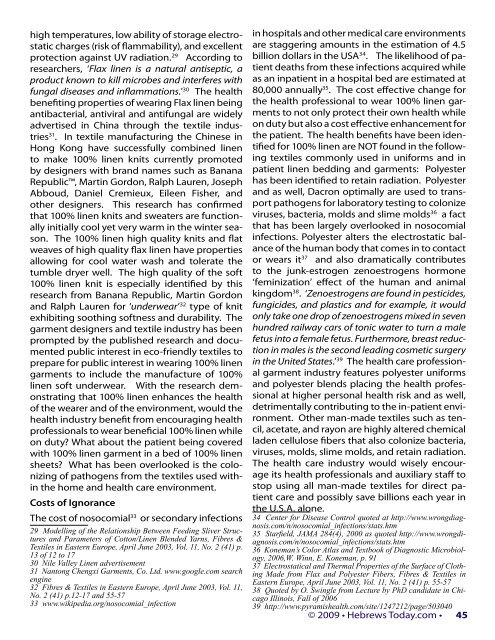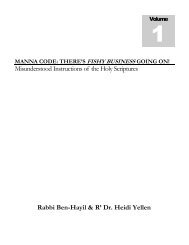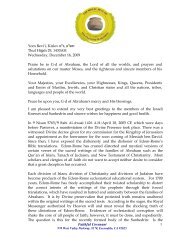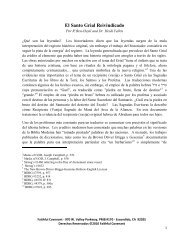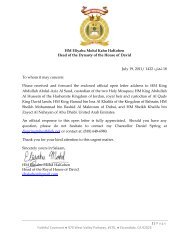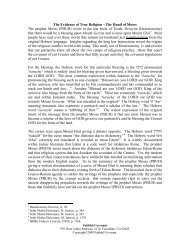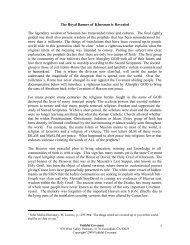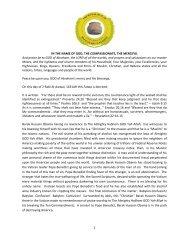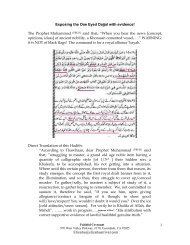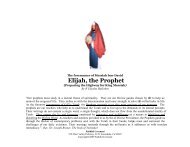Hebrew Medicine Vol 2 No 7 (2).pdf - Official Website of Imam Mahdi ...
Hebrew Medicine Vol 2 No 7 (2).pdf - Official Website of Imam Mahdi ...
Hebrew Medicine Vol 2 No 7 (2).pdf - Official Website of Imam Mahdi ...
You also want an ePaper? Increase the reach of your titles
YUMPU automatically turns print PDFs into web optimized ePapers that Google loves.
high temperatures, low ability <strong>of</strong> storage electrostatic<br />
charges (risk <strong>of</strong> flammability), and excellent<br />
protection against UV radiation. 29 According to<br />
researchers, ‘Flax linen is a natural antiseptic, a<br />
product known to kill microbes and interferes with<br />
fungal diseases and inflammations.’ 30 The health<br />
benefiting properties <strong>of</strong> wearing Flax linen being<br />
antibacterial, antiviral and antifungal are widely<br />
advertised in China through the textile industries31<br />
. In textile manufacturing the Chinese in<br />
Hong Kong have successfully combined linen<br />
to make 100% linen knits currently promoted<br />
by designers with brand names such as Banana<br />
Republic, Martin Gordon, Ralph Lauren, Joseph<br />
Abboud, Daniel Cremieux, Eileen Fisher, and<br />
other designers. This research has confirmed<br />
that 100% linen knits and sweaters are functionally<br />
initially cool yet very warm in the winter season.<br />
The 100% linen high quality knits and flat<br />
weaves <strong>of</strong> high quality flax linen have properties<br />
allowing for cool water wash and tolerate the<br />
tumble dryer well. The high quality <strong>of</strong> the s<strong>of</strong>t<br />
100% linen knit is especially identified by this<br />
research from Banana Republic, Martin Gordon<br />
and Ralph Lauren for ‘underwear’ 32 type <strong>of</strong> knit<br />
exhibiting soothing s<strong>of</strong>tness and durability. The<br />
garment designers and textile industry has been<br />
prompted by the published research and documented<br />
public interest in eco-friendly textiles to<br />
prepare for public interest in wearing 100% linen<br />
garments to include the manufacture <strong>of</strong> 100%<br />
linen s<strong>of</strong>t underwear. With the research demonstrating<br />
that 100% linen enhances the health<br />
<strong>of</strong> the wearer and <strong>of</strong> the environment, would the<br />
health industry benefit from encouraging health<br />
pr<strong>of</strong>essionals to wear beneficial 100% linen while<br />
on duty? What about the patient being covered<br />
with 100% linen garment in a bed <strong>of</strong> 100% linen<br />
sheets? What has been overlooked is the colonizing<br />
<strong>of</strong> pathogens from the textiles used within<br />
the home and health care environment.<br />
Costs <strong>of</strong> Ignorance<br />
The cost <strong>of</strong> nosocomial33 or secondary infections<br />
29 Modelling <strong>of</strong> the Relationship Between Feeding Sliver Structures<br />
and Parameters <strong>of</strong> Cotton/Linen Blended Yarns, Fibres &<br />
Textiles in Eastern Europe, April June 2003, <strong>Vol</strong>. 11, <strong>No</strong>. 2 (41) p.<br />
13 <strong>of</strong> 12 to 17<br />
30 Nile Valley Linen advertisement<br />
31 Nantong Chengxi Garments, Co. Ltd. www.google.com search<br />
engine<br />
32 Fibres & Textiles in Eastern Europe, April June 2003, <strong>Vol</strong>. 11,<br />
<strong>No</strong>. 2 (41) p.12-17 and 55-57<br />
33 www.wikipedia.org/nosocomial_infection<br />
in hospitals and other medical care environments<br />
are staggering amounts in the estimation <strong>of</strong> 4.5<br />
billion dollars in the USA<br />
© 2009 • <strong>Hebrew</strong>s Today.com • 45<br />
34 . The likelihood <strong>of</strong> patient<br />
deaths from these infections acquired while<br />
as an inpatient in a hospital bed are estimated at<br />
80,000 annually35 . The cost effective change for<br />
the health pr<strong>of</strong>essional to wear 100% linen garments<br />
to not only protect their own health while<br />
on duty but also a cost effective enhancement for<br />
the patient. The health benefits have been identified<br />
for 100% linen are NOT found in the following<br />
textiles commonly used in uniforms and in<br />
patient linen bedding and garments: Polyester<br />
has been identified to retain radiation. Polyester<br />
and as well, Dacron optimally are used to transport<br />
pathogens for laboratory testing to colonize<br />
viruses, bacteria, molds and slime molds36 a fact<br />
that has been largely overlooked in nosocomial<br />
infections. Polyester alters the electrostatic balance<br />
<strong>of</strong> the human body that comes in to contact<br />
or wears it37 and also dramatically contributes<br />
to the junk-estrogen zenoestrogens hormone<br />
‘feminization’ effect <strong>of</strong> the human and animal<br />
kingdom38 . ‘Zenoestrogens are found in pesticides,<br />
fungicides, and plastics and for example, it would<br />
only take one drop <strong>of</strong> zenoestrogens mixed in seven<br />
hundred railway cars <strong>of</strong> tonic water to turn a male<br />
fetus into a female fetus. Furthermore, breast reduction<br />
in males is the second leading cosmetic surgery<br />
in the United States.’ 39 The health care pr<strong>of</strong>essional<br />
garment industry features polyester uniforms<br />
and polyester blends placing the health pr<strong>of</strong>essional<br />
at higher personal health risk and as well,<br />
detrimentally contributing to the in-patient environment.<br />
Other man-made textiles such as tencil,<br />
acetate, and rayon are highly altered chemical<br />
laden cellulose fibers that also colonize bacteria,<br />
viruses, molds, slime molds, and retain radiation.<br />
The health care industry would wisely encourage<br />
its health pr<strong>of</strong>essionals and auxiliary staff to<br />
stop using all man-made textiles for direct patient<br />
care and possibly save billions each year in<br />
the U.S.A. alone.<br />
34 Center for Disease Control quoted at http://www.wrongdiagnosis.com/n/nosocomial_infections/stats.htm<br />
35 Starfield, JAMA 284(4), 2000 as quoted http://www.wrongdiagnosis.com/n/nosocomial_infections/stats.htm<br />
36 Koneman’s Color Atlas and Textbook <strong>of</strong> Diagnostic Microbiology,<br />
2006,W. Winn, E. Koneman, p. 91<br />
37 Electrostatical and Thermal Properties <strong>of</strong> the Surface <strong>of</strong> Clothing<br />
Made from Flax and Polyester Fibers, Fibres & Textiles in<br />
Eastern Europe, April June 2003, <strong>Vol</strong>. 11, <strong>No</strong>. 2 (41) p. 55-57<br />
38 Quoted by O. Swingle from Lecture by PhD candidate in Chicago<br />
Illinois, Fall <strong>of</strong> 2006<br />
39 http://www.pyramishealth.com/site/1247212/page/503040


